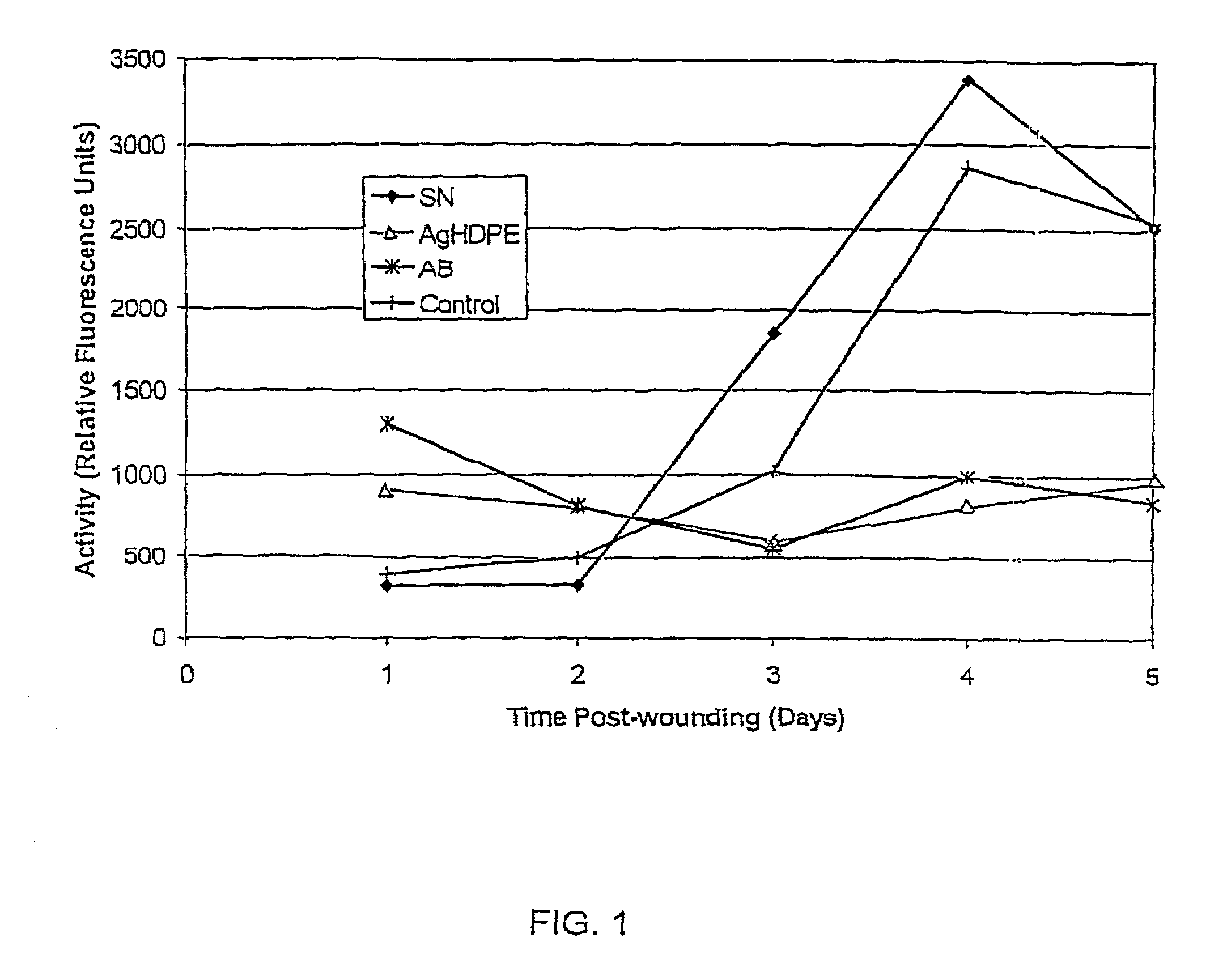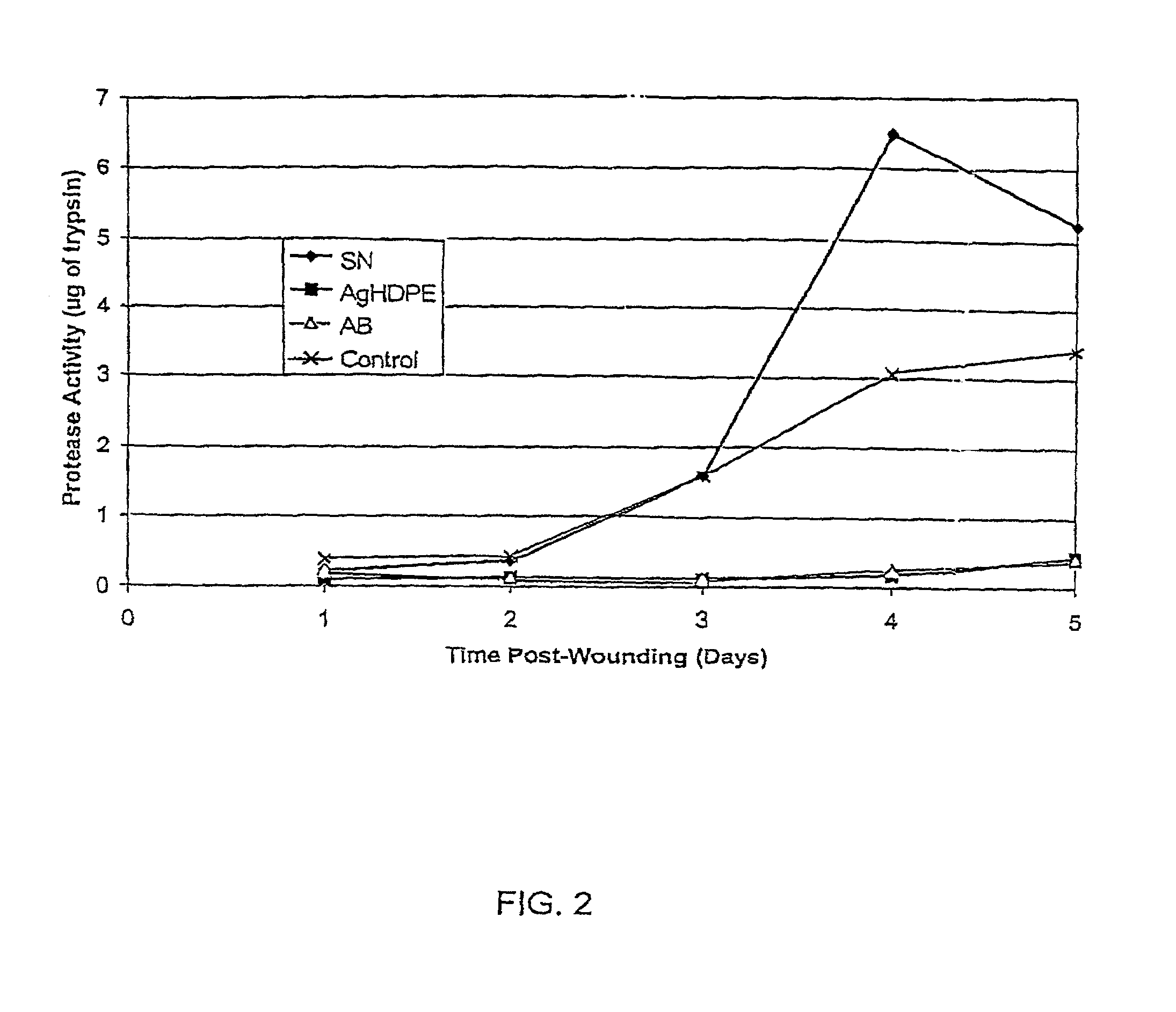Method of induction of apoptosis and inhibition of matrix metalloproteinases using antimicrobial metals
- Summary
- Abstract
- Description
- Claims
- Application Information
AI Technical Summary
Benefits of technology
Problems solved by technology
Method used
Image
Examples
example 1
Preparation of Nanocrystalline Silver Coatings on Dressings
[0180]This example shows the preparation of a bilayer nanocrystalline silver coating on a dressing material. A high density polyethylene dressing, DELNET™ or CONFORMANT 2™ was coated with a silver base layer and a silver / oxide top layer to generate a coloured antimicrobial coating having indicator value. The coating layers were formed by magnetron sputtering under the conditions set out in Table 1.
[0181]
TABLE 1Sputtering conditionsSputtering ConditionsBase LayerTop LayerTarget99.99% Ag99.99% AgTarget Size20.3 cm diameter20.3 cm diameterWorking Gas96 / 4 wt % Ar / O296 / 4 wt % Ar / O2Working Gas Pressure5.33 Pa (40 mT)5.33 Pa (40 mT)Power0.3 kW0.15 kWSubstrate Temperature20° C.20° C.Base Pressure3.0 × 10−6 Torr3.0 × 10−6 Torr(4 × 10−4 Pa)(4 × 10−4 Pa)Anode / Cathode100 mm100 mmDistanceSputtering Time7.5–9 min1.5 minVoltage369–373 V346 V
The resulting coating was blue in appearance. A fingertip touch was sufficient to cause a colour cha...
example 2
Preparation of Atomic Disordered Nanocrystalline Silver Powders
[0190]Nanocrystalline silver coatings were prepared by sputtering silver in an oxygen-containing atmosphere directly onto an endless stainless steel belt of a magnetron sputtering roll coater, or onto silicon wafers on the belt. The belt did not need to be cooled. The coatings were scraped off with the belt with suspended metal scrapers as the belt rounded the end rollers. For the coated silicon wafers, the coatings were scraped off with a knife edge. The sputtering conditions were as follows:
[0191]
TABLE 2Sputtering ConditionsTarget99.99% AgTarget Size (individual, 2315.24 cm × 1216.125 cmtargets)Working Gas75:25 wt % Ar / O2Working Gas Pressure5.33 Pa (40 mT)Total Current40 ABase Pressure5.0 × 10−5 Torr (range: 1 × 10−4–9 × 10−7Torr or 1 × 10−2–1.2 × 10−4 Pa)Sandvik Belt Speed340 mm / minVoltage370 VNote - pressure conversions to Pa herein may not be accurate, most accurate numbers are in torr, mTorr units.
[0192]The powder ...
example 3
Preparation of Gels
No. 1
[0194]A commercial carboxymethyl cellulose / pectin gel (DuoDERM™, ConvaTec Canada, 555, Dr. Frederik Philips, Suite 110, St-Laurent, Quebec, H4M 2X4) was combined with nanocrystalline silver powder prepared as set forth in Example 3 to produce a gel with 0.1% silver. A logarithmic reduction test was performed as follows in the gel using Pseudomonas aeruginosa. The inoculum was prepared by placing 1 bacteriologic loopful of the organism in 5 mL of trypticase soy broth and incubating it for 3–4 h. The inoculum (0.1 mL) was then added to 0.1 mL of gel and vortexed (triplicate samples). The mixture was incubated for one-half hour. Then 1.8 mL of sodium thioglycollate-saline (STS) solution was added to the test tube and vortexed. Serial dilutions were prepared on 10−1 to 10−7. A 0.1 mL aliquot of each dilution was plated in duplicate into Petri plates containing Mueller-Hinton agar. The plates were incubated for 48 h and then colonies were counted. Surviving member...
PUM
| Property | Measurement | Unit |
|---|---|---|
| Length | aaaaa | aaaaa |
| Length | aaaaa | aaaaa |
| Percent by mass | aaaaa | aaaaa |
Abstract
Description
Claims
Application Information
 Login to View More
Login to View More - R&D
- Intellectual Property
- Life Sciences
- Materials
- Tech Scout
- Unparalleled Data Quality
- Higher Quality Content
- 60% Fewer Hallucinations
Browse by: Latest US Patents, China's latest patents, Technical Efficacy Thesaurus, Application Domain, Technology Topic, Popular Technical Reports.
© 2025 PatSnap. All rights reserved.Legal|Privacy policy|Modern Slavery Act Transparency Statement|Sitemap|About US| Contact US: help@patsnap.com



